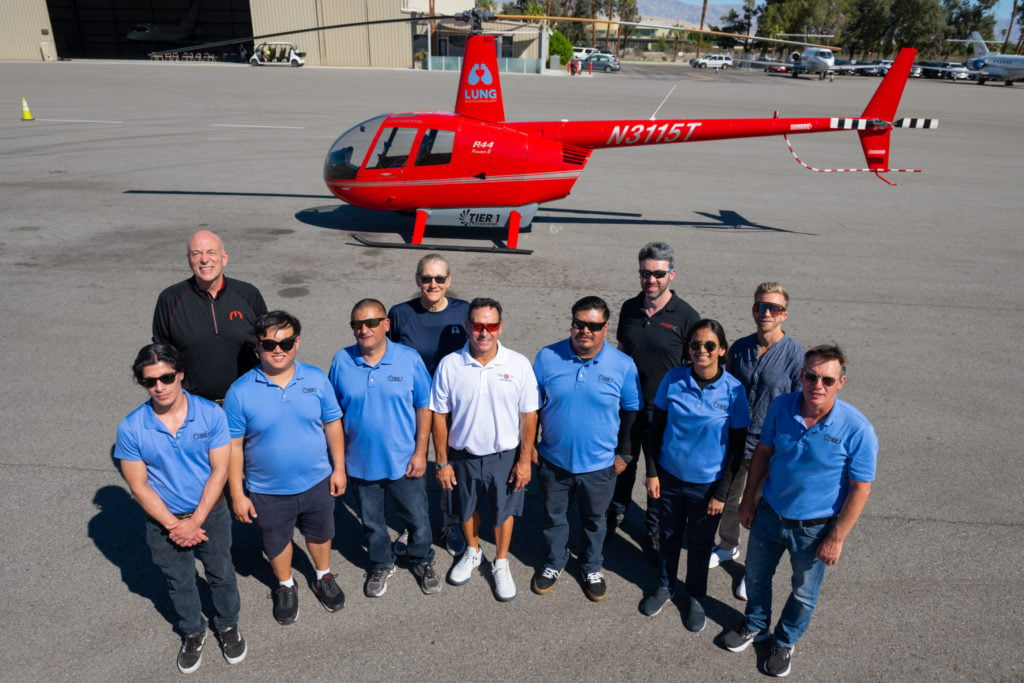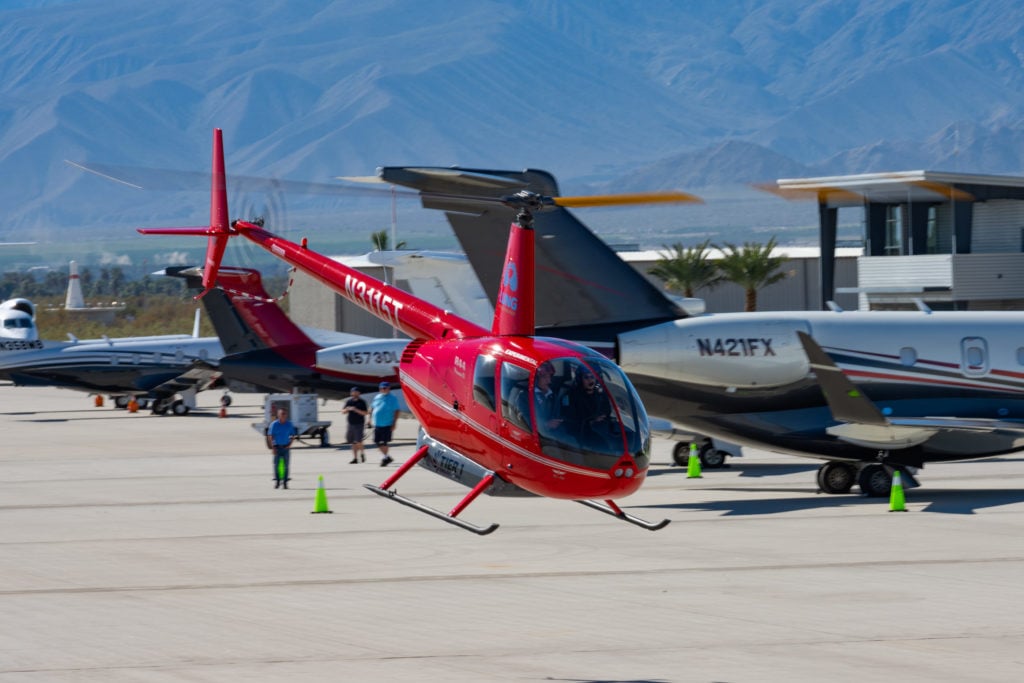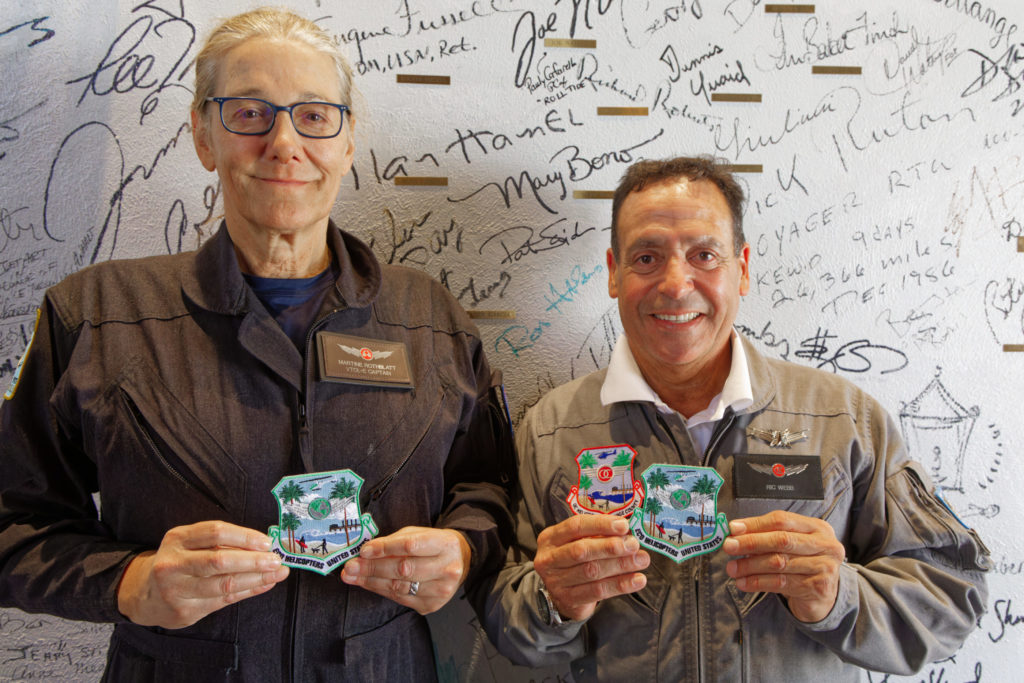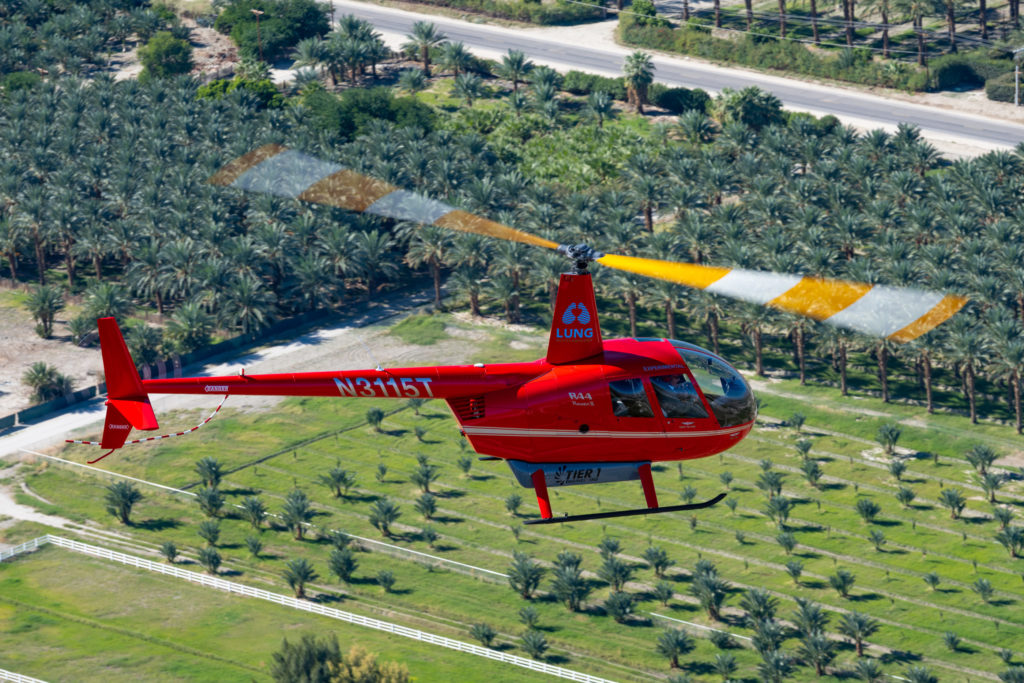Tier 1 Engineering, in collaboration with Lung Biotechnology PBC, successfully completed the first all-electric cross-country helicopter flight along the scenic Coachella Valley of California on Oct. 29, 2022.

The third-generation battery-electric e-R44 conversion of the popular Robinson R44 helicopter was piloted by Ric Webb, CEO of part 135 charter operator OC Helicopters, and Dr. Martine Rothblatt, CEO of United Therapeutics. The aircraft was outfitted with a 50-pound (23-kilogram) payload to simulate a transplant organ care system in the rear cabin.
The helicopter took off from Jacqueline Cochran Airport (KTRM) and landed at Palm Springs International Airport (KPSP) at 11:11 a.m., covering the FAA-approved 24-mile (39-kilometer) route in a flight time of 20 minutes.
The e-R44 was greeted by dozens of guests invited to Palm Springs Airport by Tier 1 Engineering and United Therapeutics, the project sponsor, to witness the historic occasion.
“This was the first ever electric helicopter flight between two cities and between two airports,” said Rothblatt, adding that it demonstrated “it is practical to deliver transplantable organs by electric helicopters from hospital to hospital.”
Glen Dromgoole, president of Tier 1 Engineering, said the e-R44 is capable of flying 20-minute trips “with a good reserve,” noting the battery cells had a 50 percent state of charge (SOC) on landing.
“We believe we’re developing a really practical solution for short duration rotorcraft flights such as organ deliveries, pilot training, scenic tours and other inner-city trips,” he said.
Dromgoole noted that major achievements in aviation often start with flying short distances, such as the first non-stop airplane flight across the English Channel in 1909 and the first commercial helicopter flight in 1947, which covered a similar flying distance to this flight with the e-R44.
First Generation e-R44
An accomplished fixed-wing and helicopter pilot, Rothblatt started researching the feasibility of electric vertical flight about six years ago and shared the specifications of zero-emissions electric rotorcraft with a number of aerospace companies to launch a research project.

Dromgoole was the first person to positively respond to Rothblatt’s line of inquiry. Tier 1 Engineering received a contract in early 2016 to rapidly build and fly a proof-of-concept electric helicopter.
UT subsidiary Lung Biotechnology purchased a 2006 model R44 Raven II (registration N3115T) for about $300,000. Dromgoole’s team removed the aircraft’s bulky 260-hp Lycoming IO-540-AE1A5, which weighed about 500 lb. (225 kg), including accessories, as well as the complete fuel system.
The engine and fuel system were then replaced with an electric propulsion system primarily sourced from the automotive industry, including two early YASA P400HC electric motors (stacked in parallel and powered by separate inverters), lithium polymer batteries made for the Brammo electric motorcycle, inverter/motor controllers made by Formula 1 hybrid-electric supplier Rinehart Motion Systems, and a reduction gearbox made by Autoflight.
The YASA motor was light enough to install by hand and could achieve the rated power required for the R44, producing peak shaft power of 183 kW (245 hp) for five minutes and continuous shaft power of 153 kW (205 hp).
Webb made the first successful hover of the first-generation e-R44 at Los Alamitos Army Airfield (KSLI) on Sept. 13, 2016, its first hover-taxi the following day, and a record five-minute cruise flight on Sept. 21, which drained approximately 20 percent of the battery energy.
On Feb. 16, 2017, Tier 1 Engineering established a series of world records for “duration, altitude, payload, weight and speed of battery-powered rotorcraft or helicopter flight” at Los Alamitos Army Airfield, six miles (9.6 kilometers) east of Long Beach Airport.
The flight lasted 30 minutes, reached 800 feet (244 meters) and a peak speed of 80 knots (148 km/h) with an eight percent battery state-of-charge remaining after a safe hover landing.
Then to claim the world’s first two-pilot electric helicopter flight, the battery capacity was reduced by 18 percent to allow Rothblatt to fly with Webb.
On Dec. 7, 2018, Tier 1 Engineering set a Guinness World Record when Webb flew the farthest distance traveled by an electric helicopter, covering 30.7 nautical miles (56.87 kilometers) at an average speed of 80 knots (148 km/h) over a circular course entirely within the confines of the Los Alamitos military base.
Aircraft Optimization
After the record flights, Tier 1 set out to optimize the e-R44 design and replace the automotive systems with hardware that could be certified for aviation.

The first improvement was cutting the weight of the battery pack from 1,100 lb. (500 kg) to 800 lb. (365 kg) by early 2020. This was achieved by using higher energy-density cells and a streamlined structure to support them. It meant the e-R44 could fly with a pilot, co-pilot and organ transfer system.
When the second electric motor and invertor did not perform as expected during ground tests, Tier 1 transferred the YASA motor and Rinehart Motion Systems inverters to the second-generation e-R44.
The second iteration of the design included four independent onboard liquid cooling systems in the engine bay for the motors (packaged as a single unit), the inverters, reduction gearbox and battery pack.
In the cockpit, the twist grip throttle on the collective was removed and rotor RPM is now fully controlled by the electric motor controller. “There is no need for pilot input into the throttle,” said Dromgoole in an earlier interview with the author during the Vertical Flight Society’s 9th Annual eVTOL Symposium in San Jose in January 2022.
The toggle switch on the end of the right seat collective used to switch the RPM governor on and off is now used to select 100 percent RPM for normal operations, or 90 percent RPM to allow autorotation training. That allows the pilot during a practice autorotation to adjust the rotor speed using the cyclic and collective, and “if the rotor RPM was to drop to 90 percent or less, the motor will automatically pick up and apply torque, which is an added safety feature,” Dromgoole explained.
New magniX Motor
In December 2021, the e-R44 program gained renewed momentum when Tier 1 Engineering selected the magniX magni250 electric motor.

“magniX was chosen as they are leading the industry in the development of aviation-specific electric propulsion, and we recognized that significant progress had been made towards obtaining FAA certification,” said Dromgoole when the motor deal was announced. “With magniX’s technology, we are now much closer to obtaining a supplemental type certificate [STC] approval of the e-R44 and transforming the delivery of life-saving human organs,”
Tier 1 took delivery of a prototype magni250 on Dec. 6, 2021, to integrate into its third-generation e-R44, which will be the basis for its FAA STC application. The airframe of the proof-of-concept e-R44 aircraft, N3115T, is being reused as a platform for the new electric motor.
The Magni250 is twice the diameter of the YASA motor, but is a better match to the speed and torque of the original Lycoming IO-540-AEA5 engine.
This has helped to simplify the rotor drive system on the third-generation e-R44 by replacing the engine reduction gearbox (required for the 5,600 RPM YASA motor) as well as the R44’s original vee-belt drive and automatic tensioner with a synchronous belt drive. The changes have simplified pilot workload and result in additional weight savings.
The initial ground runs of the third-generation e-R44 began on March 31, 2022, with Webb and Rothblatt performing system checks to validate the cooling system and engine controls of the magni250.
This was followed by first flight at Los Alamitos on June 4, which lasted three minutes, with Webb and Rothblatt again at the controls.
Cross Country Flight
Tier 1 Engineering has been planning a cross-country e-R44 flight for several years, but ground and air testing of the new propulsion system needed to mature before the FAA would grant the required flight permit.

Since the first flight, the helicopter had completed 16 test flights totaling approximately three hours, as well as extensive testing at full power with the e-R44 anchored to the ground through the summer.
It was brought by trailer to Thermal Airport in the week prior to the flight, along with a ground charging unit.
On the morning of the record setting flight, Webb and Rothblatt flew the approved route in a piston-engine Robinson R44 owned by Lung Biotechnology shortly before they took off in the e-R44.
Webb said one of the novelties of the flight was that the e-R44 electric engine doesn’t emit a lot of heat in flight or on landing.
There are still gaps in the FAA regulations when it comes to addressing electric aircraft, even if it is an STC conversion rather than a clean sheet design.
One challenge for any electric aircraft developer will be to demonstrate the “means of compliance” with the new regulations to validate the electric propulsion systems.
That’s why Tier 1 has been an active participant in industry committees interpreting airworthiness standards and developing consensus standards specifically for electric propulsion systems.
While the e-R44 offers a zero emissions means of performing traditional helicopter flights, Dromgoole believes that the business case for the aircraft will also include about a 20 percent reduction in noise (from the engine) and a 20 percent reduction in operating costs compared to a piston R44, as a result of maintenance savings and lower energy costs.
The exact cost saving will only be known once the cost and replacement life of the battery cells is known, and this has been changing over time.
Tier 1 also sees a market opportunity for the e-R44 in regions of the world where aviation gasoline is very expensive or unavailable. This includes nearby Catalina Island Airport, 34 miles (54 kilometers) offshore from Los Alamitos Army Airfield.
The company believes that the best time to convert an R44 to electric propulsion is during the factory mandated 2,200-hour or 12-year overhaul of the helicopter, which typically costs more than $230,000 and includes an engine exchange.
It plans to open e-R44 conversion line at its facility in Santa Ana to fill orders from Lung Biotechnology and Webb’s OC Helicopters, which was the first charter helicopter operator to place an order for the e-R44.
As Dromgoole left Palm Springs Airport after a momentous day, he paid tribute to Tier 1’s small team of multitalented employees
“I’m really proud of the team today. They’ve done a lot of work. It’s taken a lot of time to get to this point.”










20 minute flight with a 50lb payload? Not exactly going to set the world on fire. What was the recharge time?